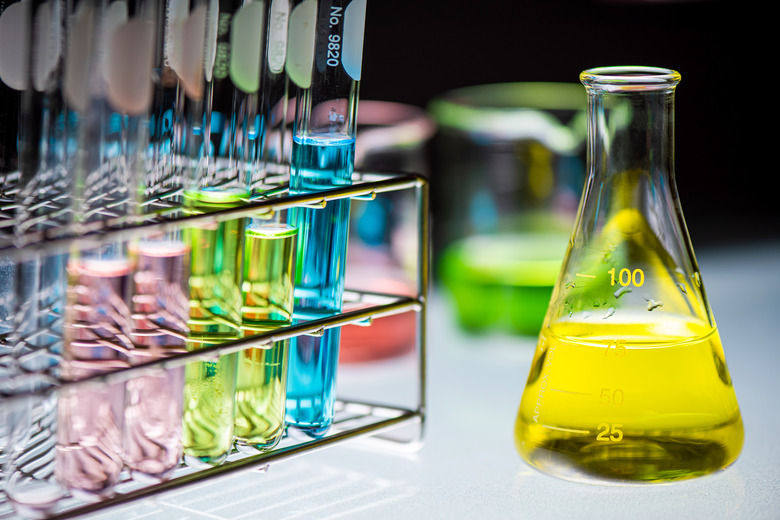How To Store Acids & Bases
Both acids and bases are chemicals that present health hazards if inappropriately handled or stored. Handling chemicals incorrectly can lead to spills in the lab, fires, toxic environments and bodily damage. Therefore it is always important to practice safety in the laboratory by working slowly and carefully when storing acids and bases, and always wearing your protective equipment. Below are steps on how to safely and effectively store acids and bases.
Step 1
Label the container you will use to store the acid or base. Make sure to write legibly so that the contents of the jar won't be mistaken. You can use tape and a marker if there isn't a label on the container already.
Step 2
Pour the acid or base into the container. To help avoid spills you can use a funnel. Carefully pour the liquid into the container, making sure to pour the entire amount to avoid measurement discrepancies.
Step 3
Close the lid of the container tightly. Many times lids are not securely closed on the container, causing toxic fumes and liquid to escape into the air. This could potentially contaminate the lab and affect your respiratory system, therefore it is very important to double-check that the lid is completely closed.
Step 4
Place the container in the location designated for the chemical. Acids and Bases are broken down into several different categories of storage due to their differing chemical properties and the hazards they present. Some chemicals are mild enough to be stored on a shelf or in a cabinet, but other chemicals must be stored in such places like refrigeration units and flammable lockers, such as Ammonium Nitrate and Chromic Acid. You can find the designations for many of these acids and bases by clicking on the links in the Resources section below.
Things Needed
- Containers (glass jars, plastic bottles, flasks or beakers)
- Protective equipment (goggles, gloves, lab coat or apron, chemically-resistant clothing)
- Locations designated for the acid or base (shelves, drip trays, flammable lockers, refrigerators)
TL;DR (Too Long; Didn't Read)
Refer to the Material Safety Data Sheet, or MSDS, in your lab to learn about the chemical properties of the acids and bases. MSDS will also assist you in determining what chemicals can and can not be stored together. Know where all of the eye wash, shower stations and fire extinguishers are in case of emergencies.
Warning
Wear protective equipment such as goggles, gloves, and chemical-resistant clothing at all times while in the laboratory. Always ask for assistance if you are unsure or uncomfortable with storing acids and bases Exercise extreme caution while handling any glassware. If you drop a glass instrument or container, follow posted lab instructions for cleaning up broken glass. Refer to posted lab instructions for cleaning up chemical spills. Never touch the chemical with your bare hands. Seek help if you don't know what to do.
Cite This Article
MLA
Writer, Contributing. "How To Store Acids & Bases" sciencing.com, https://www.sciencing.com/how-4501320-store-acids-bases/. 3 September 2008.
APA
Writer, Contributing. (2008, September 3). How To Store Acids & Bases. sciencing.com. Retrieved from https://www.sciencing.com/how-4501320-store-acids-bases/
Chicago
Writer, Contributing. How To Store Acids & Bases last modified August 30, 2022. https://www.sciencing.com/how-4501320-store-acids-bases/
